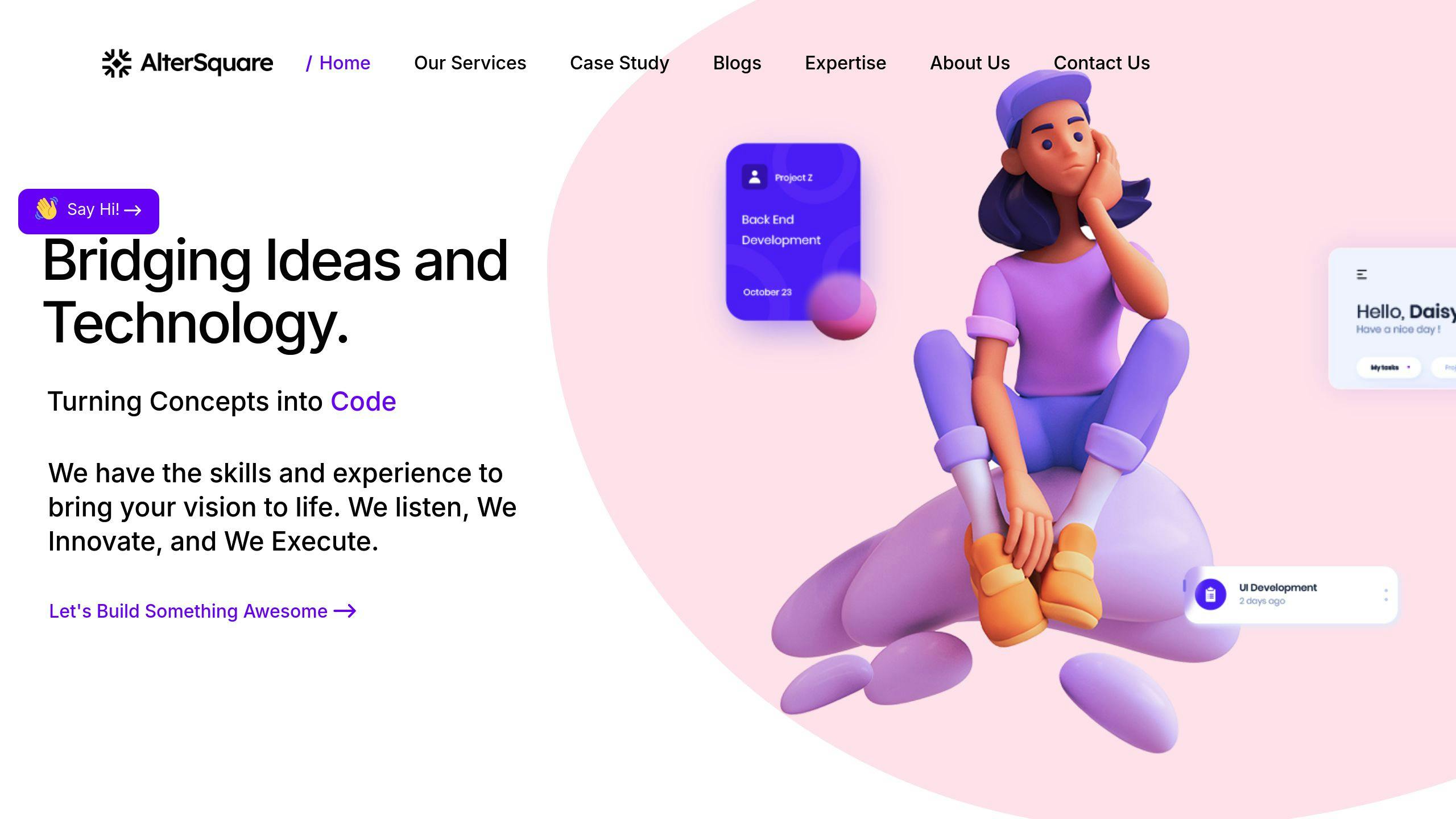Legacy systems are outdated but critical technologies that can slow down business growth. Modernizing them improves performance, security, and scalability while reducing costs. Here’s what you need to know:
- Signs Your System Needs Modernization: Frequent downtime, slow performance, security gaps, and poor integration.
- Benefits of Modernization: Faster systems, lower maintenance costs, enhanced security, and better scalability.
-
Modernization Strategies:
- Big Bang: Full system replacement.
- Incremental: Gradual updates while keeping systems operational.
- Replatforming: Moving to modern infrastructure.
- Refactoring: Restructuring existing code.
- Microservices: Breaking monolithic systems into smaller, scalable components.
-
Steps to Modernize:
- Assess your system’s weaknesses.
- Align updates with business goals.
- Choose the right strategy.
- Plan, budget, and execute in phases.
- Monitor performance continuously.
Quick Comparison of Strategies:
| Strategy | Best For | Risk Level | Cost |
|---|---|---|---|
| Big Bang | Complete system overhaul | High | High |
| Incremental | Gradual updates | Moderate | Spread out |
| Replatforming | Infrastructure upgrades | Moderate | Medium |
| Refactoring | Code restructuring | Low | Low |
| Microservices | Scalability and flexibility | Moderate | Continuous |
Modernizing legacy systems ensures they remain efficient, secure, and aligned with future business needs. Start by evaluating your systems, defining your goals, and selecting the best strategy to minimize disruptions and maximize results.
Evaluating Current Systems and Identifying Needs
Spotting Legacy Systems
Legacy systems often show signs of frequent downtime, security issues, performance slowdowns, and limited compatibility with newer technologies. To assess these systems effectively, focus on these areas:
| Evaluation Area | Warning Signs | Impact |
|---|---|---|
| Technology Stack | Unsupported versions, outdated languages | Increased costs, security risks |
| System Performance | Slow response times, frequent crashes | Reduced productivity |
| Integration Capabilities | Limited API support, manual workflows | Operational inefficiency |
| Security Features | Outdated protocols, known vulnerabilities | Compliance challenges |
Identifying these warning signs is the first step. From there, use structured evaluation methods to dive deeper into the system’s shortcomings.
Using Evaluation Tools
Tools like Gartner‘s IT assessment framework offer measurable benchmarks to gauge system performance and readiness for modernization. These tools can help you create a clear roadmap for improvement.
Key metrics to monitor include:
- System uptime and downtime
- Performance efficiency and resource use
- Maintenance expenses
- User satisfaction scores
Aligning with Business Goals
Legacy systems often struggle with downtime, security gaps, and integration hurdles. To ensure your modernization efforts deliver real value, technical evaluations must align with your business priorities.
| Business Objective | Technical Consideration | Modernization Focus |
|---|---|---|
| Market Agility | Flexibility | Transition to microservices |
| Cost Optimization | Operational efficiency | Move to cloud solutions |
| Customer Experience | Improved performance | Enhance UI/UX design |
| Innovation Capacity | Seamless integration | Adopt API-first architecture |
"Modernization is not necessarily about replacing these applications entirely, but rather about revitalizing them to meet contemporary needs and standards." – IBM [2]
Modernizing your systems ensures they can support future technologies and evolving market demands, such as cloud computing, artificial intelligence, and advanced analytics. By understanding your system’s weaknesses and aligning them with business goals, you can confidently choose the best modernization strategy.
How to Escape the Legacy Trap: A Proven Strategy for Application Modernization
Choosing a Modernization Strategy
Once you’ve assessed the needs of your legacy systems, the next step is selecting the best modernization approach. This decision can determine whether your transition is smooth or fraught with challenges.
Comparing Strategies
Here’s a breakdown of common modernization strategies, their features, and when to use them:
| Strategy | Characteristics | Best For | Risk Level | Resource Requirements |
|---|---|---|---|---|
| Big Bang | Full system replacement | Systems needing a complete overhaul | High | High upfront investment |
| Incremental | Gradual updates | Systems that can run during updates | Moderate | Costs spread over time |
| Replatforming | Shift to new infrastructure | Performance-focused improvements | Moderate | Medium investment |
| Refactoring | Restructuring existing code | Systems with strong core functionality | Low | Lower initial costs |
| Microservices | Breaking monolithic systems | Scalability and flexibility upgrades | Moderate | Continuous investment |
Factors for Strategy Selection
Your choice should align with your business’s specific needs and constraints. Keep these key factors in mind:
-
System Criticality
For mission-critical systems, incremental updates are often safer, as they reduce operational risks and maintain stability. -
Resource Availability
Evaluate your team’s skills and your budget. Think about:- Upfront costs
- Team capacity
- Training needs
- Testing timelines
-
Business Impact
Assess how modernization might affect operations, including downtime, customer experience, and compliance. For example, while microservices improve scalability and maintenance, they require careful planning and expertise to implement effectively [2].
With your strategy chosen, the next step is to map out and execute the modernization process efficiently.
sbb-itb-51b9a02
Guide to Modernizing Legacy Systems
Planning and Budgeting
Once a strategy is outlined, the next step is organizing resources to ensure a smooth modernization process. Instead of completely replacing systems, organizations should consider a phased approach to modernization [3].
When creating a modernization budget, be sure to account for the following:
| Cost Category | Components | Considerations |
|---|---|---|
| Technical Infrastructure | Hardware, software licenses, cloud services | Cover initial setup and ongoing operational costs |
| Personnel | Training, hiring, consulting | Address skill gaps and time needed for training |
| Implementation | Development tools, testing environments | Plan for immediate and long-term needs |
| Contingency | Risk mitigation, unexpected issues | Set aside 15-20% of the total budget for surprises |
Implementation Phases
Modernizing legacy systems involves three main phases. Each phase builds on the last, ensuring a smooth transition.
Phase 1: Assessment and Design
Analyze the current architecture and design a roadmap for the updated system. Use tools for continuous code quality checks to catch potential issues early [4].
Phase 2: Development and Testing
Start implementing the modernization plan while keeping the old system functional. Modern frameworks make it easier to integrate new components with the existing ones [4].
Phase 3: Deployment and Validation
Roll out the updated components, using automated CI/CD processes to monitor stability and ensure the system runs smoothly [4].
These steps create a structured approach for upgrading systems with minimal disruption.
Reducing Downtime with Phased Rollouts
Modern tools make transitions smoother by employing these strategies:
Running Legacy and Modernized Systems Simultaneously
Keep operations running by syncing data between the old and updated systems [4].
Gradual Component Migration
Leverage container orchestration to update systems one piece at a time. This approach allows for:
- Seamless, step-by-step updates
- Ongoing validation of system performance
- Minimal impact on users
Performance Monitoring
Continuously track system health and performance metrics during the process. This helps confirm successful deployments and quickly spot any issues.
Outsourcing and Partnering for Modernization
Phased rollouts help reduce disruptions, but outsourcing modernization efforts can make the process even smoother by tapping into outside expertise.
Benefits of Outsourcing
Outsourcing the modernization of legacy systems offers several key advantages for businesses aiming for efficient tech upgrades.
| Benefit | Description | Impact |
|---|---|---|
| Cost Efficiency & Scalability | Makes better use of resources, adjusts scaling needs, and avoids extra hiring/training costs | Cuts operational costs and boosts flexibility |
| Technical Expertise | Provides access to skilled professionals with modernization know-how | Speeds up implementation and avoids tech roadblocks |
| Risk Management | Reduces risks like downtime, security breaches, and compliance issues | Ensures smoother operations and more reliability |
Choosing the Right Partner
The success of your modernization project often depends on selecting the right outsourcing partner. Look for these qualities:
- Proven Expertise: Knowledge of modern tech stacks, strong project management, and clear communication.
- Industry Knowledge: Understanding of your sector’s regulations, standards, and unique challenges.
- Security Emphasis: Solid data protection measures and compliance with legal requirements.
About AlterSquare

AlterSquare’s I.D.E.A.L Delivery Framework is a great example of how outsourcing can drive modernization efforts. This approach focuses on quick transformations, scalable system design, and minimal operational disruptions, aligning perfectly with business goals.
Key features of the framework include:
- Scalable system architecture
- Performance improvements with minimal impact on customers
- Ongoing technical support and maintenance
With the right outsourcing partner, businesses can confidently focus on growth and future innovations.
Conclusion and Next Steps
Key Points
Modernizing legacy systems requires thoughtful planning and execution. Recent statistics show that over half of companies focus on improving security and efficiency as their main reasons for modernization efforts [1]. Success hinges on identifying system weaknesses, choosing the right approach, and ensuring minimal disruption during implementation.
Preparing for the Future
Today’s business world demands systems that can keep up with changing needs. Cloud-native designs and microservices architectures offer a solid base for solutions that scale easily and meet industry requirements [2]. To stay ahead, businesses need systems that are secure, scalable, and ready to support future advancements.
With these forward-thinking systems in mind, it’s time to move toward practical steps for modernization.
Next Steps
Start by evaluating your current systems, setting clear objectives, and seeking guidance from experienced professionals. Regular assessments and updates will help your infrastructure stay competitive in an ever-changing digital world.
For those ready to modernize, consulting with experts can lead to customized strategies that minimize disruptions. Take the first step toward modernization now to keep your business thriving in the digital era.
FAQs
How to modernize legacy applications?
Transforming legacy applications can seem daunting, but breaking it down into clear steps makes the process manageable. Here’s how to approach it:
-
System Assessment: Start by identifying key problem areas. Look at factors like:
- Response times and overall system performance
- Security issues and compliance gaps
- Challenges in integrating with modern systems
- Ongoing maintenance and support expenses
- Document Challenges: Create a prioritized list of the most pressing issues – think recurring downtime, security risks, or sluggish performance.
- Choose a Modernization Strategy: Based on your assessment, decide on the best approach for your needs. Options include replatforming, reengineering, refactoring, or rearchitecting. For more details, check out the "Choosing a Modernization Strategy" section.
-
Adopt Long-Term Solutions: Embrace technologies like cloud-native systems and microservices. These can help with:
- Scaling your system as your business grows
- Improving system flexibility and adaptability
- Streamlining integration with modern tools
- Reducing technical debt over time
- Collaborate with Experts: Work with partners who bring technical expertise, industry insight, and robust security practices to the table. Their experience can make the process smoother and more effective.
To avoid disrupting operations, roll out changes in phases and thoroughly test each step. This ensures a smooth transition while keeping your systems up and running.
If you’re unsure where to begin, consulting with modernization specialists can help you develop a plan tailored to your technical needs and business goals [5].









Leave a Reply